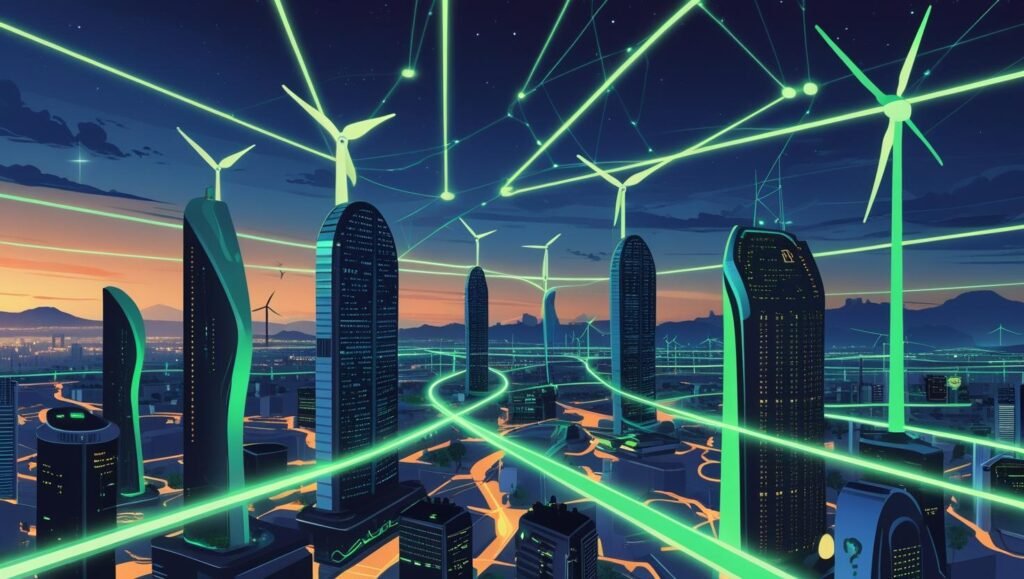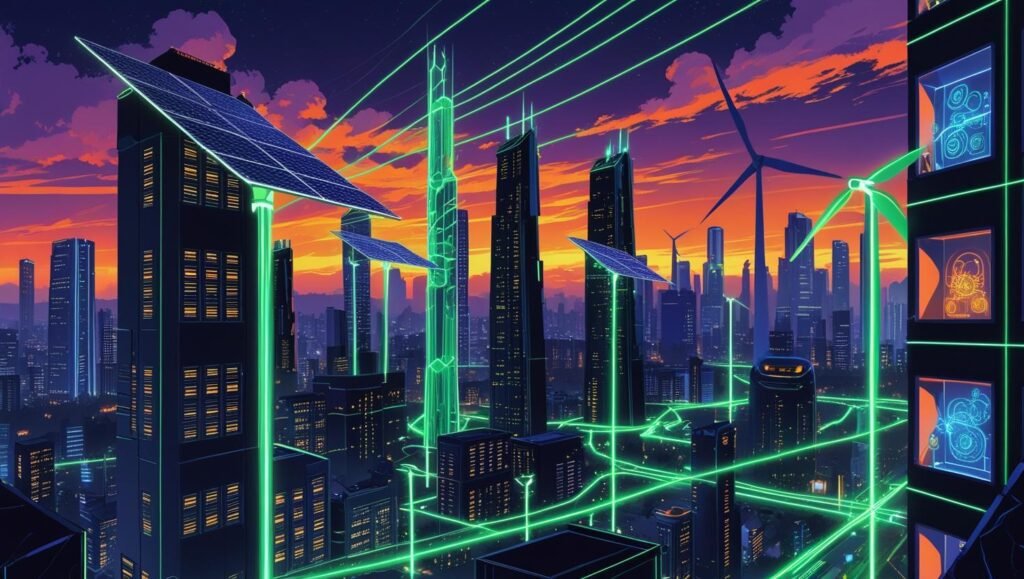Energy IoT: Smart Grids for a Greener Future

Imagine a world where your electricity works smarter, not harder. A world where power grids talk to each other, saving energy and cutting costs while protecting the planet. That’s the promise of Energy IoT, a game-changing technology that’s making our energy systems more efficient and sustainable. In this blog post, we’ll explore how Energy IoT is transforming smart grids, why it matters, and how it’s building a greener future for everyone.
What Is Energy IoT?
Energy IoT, or the Internet of Things applied to energy systems, is all about connecting devices to make energy use smarter. Think of it as a network where power meters, solar panels, and even your home appliances talk to each other. These devices share data to help manage energy better, reduce waste, and lower costs.
This technology is at the heart of smart grids. Unlike old-school power grids, smart grids use Energy IoT to monitor and control energy flow in real time. They’re like the brain of a city’s power system, making sure electricity goes where it’s needed most, without overloading the system.
Why Smart Grids Matter for a Greener Future
Traditional power grids are outdated. They’re often inefficient, wasting energy and relying heavily on fossil fuels. Smart grids, powered by Energy IoT, are changing that. Here’s why they’re so important:
- Efficiency: Smart grids reduce energy waste by balancing supply and demand in real time.
- Renewable Energy: They make it easier to use solar, wind, and other clean energy sources.
- Cost Savings: By optimizing energy use, they lower bills for homes and businesses.
- Reliability: They detect and fix power issues before they cause blackouts.
These benefits don’t just save money—they help fight climate change by cutting down on carbon emissions. Energy IoT is the key to making this happen.
How Energy IoT Powers Smart Grids
Energy IoT works by connecting devices with sensors and software. These devices collect data, like how much power your home uses or how much energy a solar panel produces. This data is sent to a central system that analyzes it and makes smart decisions. For example, if a neighborhood is using less power, the grid can redirect energy to busier areas.
Here’s a simple breakdown of how it works:
- Sensors Collect Data: Devices like smart meters track energy use in homes, offices, or factories.
- Data Gets Analyzed: The system looks at patterns, like when energy demand is high or low.
- Grids Take Action: The grid adjusts power flow, stores extra energy, or switches to renewables.
This process happens in seconds, keeping the grid efficient and reliable. Energy IoT makes sure no energy is wasted, which is great for both your wallet and the environment.
Benefits of Energy IoT for Everyday Life
Energy IoT isn’t just for power companies—it’s for you, too. Here’s how it can make your life better:
- Lower Bills: Smart meters show you when energy is cheapest, so you can run appliances like your dishwasher at the right time.
- Eco-Friendly Choices: Energy IoT helps you track your carbon footprint and switch to green energy sources.
- Fewer Outages: Smart grids fix problems before they leave you in the dark.
- Smart Homes: Connect your thermostat, lights, and appliances to save energy automatically.
For example, imagine your air conditioner turning itself down when you’re not home, or your electric car charging when solar power is at its peak. Energy IoT makes these things possible, saving you money while helping the planet.
Real-World Examples of Energy IoT in Action
Energy IoT is already changing lives around the world. In some cities, smart grids use Energy IoT to predict when power demand will spike, so they can store extra energy from wind farms. In homes, smart thermostats learn your habits and adjust heating or cooling to save energy. Even electric vehicles are part of this revolution, charging when energy is cleanest and cheapest.
One exciting example is in rural areas. Energy IoT connects small solar panels to mini-grids, bringing reliable power to communities that never had it before. This not only improves lives but also reduces reliance on polluting fuels like coal or diesel.
Challenges of Energy IoT and How to Overcome Them
No technology is perfect, and Energy IoT has its hurdles. Here are a few challenges and how we’re tackling them:
- Cost: Setting up smart grids can be expensive. Governments and companies are investing in pilot projects to bring costs down over time.
- Security: Connected devices can be hacked. Strong encryption and regular software updates keep Energy IoT systems safe.
- Complexity: Managing all that data isn’t easy. Advanced software and trained experts help make sense of it all.
By addressing these challenges, Energy IoT is becoming more reliable and accessible every day. The future looks bright as more people embrace this technology.
The Role of Renewable Energy in Energy IoT
Renewable energy, like solar and wind, is a big part of the Energy IoT story. Smart grids make it easier to use clean energy by storing it when it’s plentiful and sharing it when it’s needed. For instance, if it’s a sunny day, your solar panels might produce more power than you need. Energy IoT can store that extra energy or send it to your neighbor’s house.
This flexibility is key to reducing fossil fuel use. By combining renewables with Energy IoT, we’re creating a cleaner, greener energy system that benefits everyone.

How Energy IoT Helps Fight Climate Change
Climate change is a big problem, but Energy IoT is a powerful tool to fight it. By making energy use more efficient, smart grids reduce the need for coal and gas power plants. They also make it easier to switch to renewables, which produce little to no carbon emissions.
For example, a smart grid can prioritize wind power when it’s windy or solar power when it’s sunny. This cuts down on greenhouse gases that harm the planet. Energy IoT also helps communities recover faster from storms or other climate-related disasters by keeping power flowing where it’s needed most.
What You Can Do to Join the Energy IoT Revolution
You don’t need to be a tech expert to get involved with Energy IoT. Here are some simple steps you can take:
- Get a Smart Meter: Ask your power company if they offer smart meters to track your energy use.
- Use Smart Devices: Invest in a smart thermostat or energy-efficient appliances.
- Support Green Energy: Choose a power plan that uses solar or wind energy.
- Stay Informed: Learn about local projects that use Energy IoT to make your community greener.
Every small step counts. By making smart energy choices, you’re helping build a sustainable future.
The Future of Energy IoT
The future of Energy IoT is exciting. As technology improves, smart grids will get even smarter. We’ll see more homes and businesses using Energy IoT to save money and protect the environment. New innovations, like better batteries and smarter software, will make clean energy more reliable than ever.
In the next decade, Energy IoT could power entire cities with renewable energy, cutting emissions and creating jobs. It’s not just about technology—it’s about building a better world for future generations.
Conclusion
Energy IoT is more than just a buzzword—it’s a way to make our energy systems smarter, cleaner, and more efficient. By powering smart grids, it helps us save money, reduce waste, and fight climate change. Whether you’re using a smart meter at home or supporting renewable energy, you’re part of this green revolution. Let’s embrace Energy IoT and work together for a brighter, greener tomorrow.
FAQs
What is Energy IoT?
Energy IoT is technology that connects energy devices, like smart meters and solar panels, to make power systems more efficient and eco-friendly.
How does Energy IoT save money?
It tracks energy use in real time, so you can use power when it’s cheaper and avoid waste, lowering your bills.
Is Energy IoT safe?
Yes, with strong encryption and regular updates, Energy IoT systems are designed to be secure from cyber threats.
Can I use Energy IoT at home?
Absolutely! Smart meters, thermostats, and energy-efficient appliances let you join the Energy IoT revolution.
Read more: IoT Security: Safeguard Your Devices from Threats




